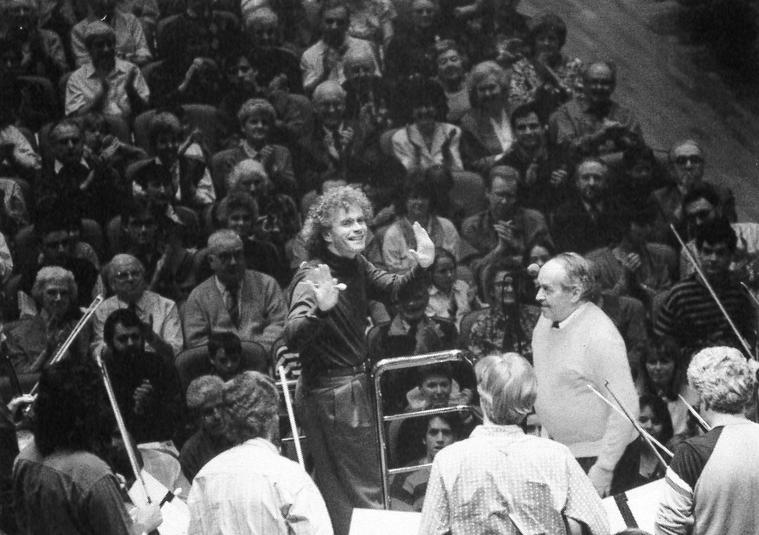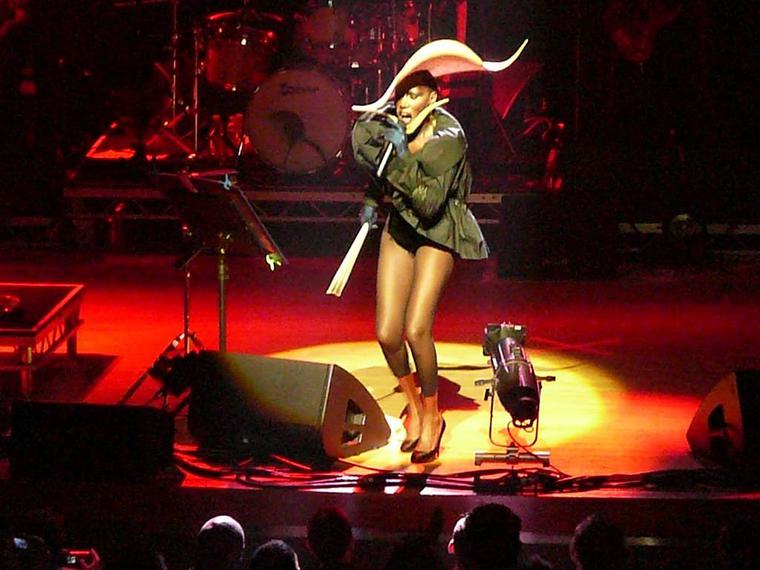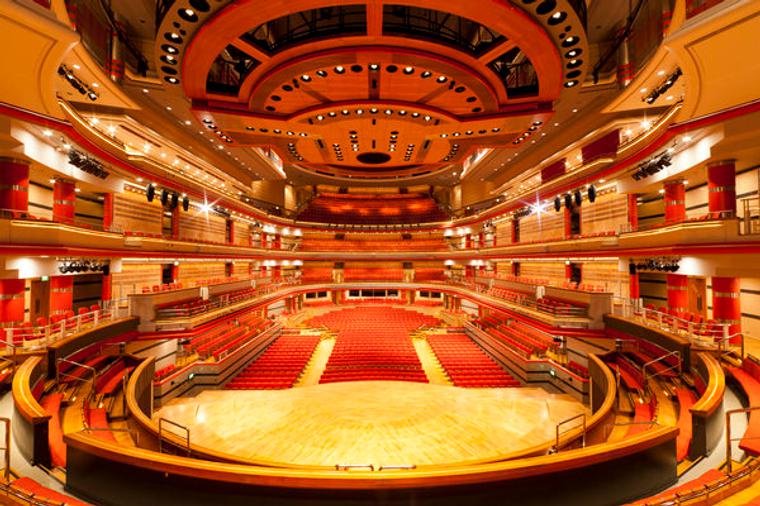Symphony Hall History
Symphony Hall History
It was Sir Simon Rattle and the City of Birmingham Symphony Orchestra who gave the first concert in Symphony Hall on 15 April 1991 – two in fact, so that double the audience could witness the occasion.

Sir Simon Rattle conducting the City of Birmingham Symphony Orchestra at Symphony Hall's Open Day, 1993
Credit: Alan Wood 1993From the moment the first notes were heard it was clear Birmingham had commissioned a masterpiece. It was described by the Sunday Times as “an acoustic triumph” and by the Daily Telegraph as “the best concert hall in the country”, a claim Symphony Hall can still justify.
Symphony Hall sits within the International Convention Centre and, together, they became a catalyst for the city’s regeneration and economic development, its industrial image giving way to a future focussed on business and tourism.
A major visitor destination for the Midlands, Symphony Hall is a ‘must-play’ venue for artists from all over the world, continuing a long musical tradition cemented in the 19th century by the internationally-renowned Birmingham Triennial Festivals for which the Town Hall was originally built.
Top international performers from all walks of musical life have stepped out onto its stage including Van Morrison, the Vienna Philharmonic, Gary Barlow, Joan Armatrading, Bruce Springsteen, Ravi Shankar, Liza Minnelli, Brian Wilson, Grace Jones and Cecilia Bartoli to name drop just a few.

Grace Jones on stage at Symphony Hall, 19 January 2009
Credit: Source: https://www.flickr.com/photos/andy-roo/4385377055/ 2009The city’s ambition to create one of the world’s great concert halls meant putting acoustic considerations ahead of the architectural plans, an unprecedented approach at that time. Acousticians Artec Consultants Inc of New York and its founder Russell Johnson were key to the scheme’s success, with the Percy Thomas Partnership as architects.
The project wasn’t without its challenges, not least that the main railway line ran in a tunnel within spitting distance of the hall itself. Rubber blocks under its pillars, an isolating gap between the hall and its surroundings, and padding beneath the railway sleepers were just some of the measures needed to achieve total silence. And it worked: acoustic tests demonstrated a pin dropped on stage could be heard anywhere in the hall.
Symphony Hall’s ‘shoebox’ design replicated world-beating concert halls like Vienna’s Musikverein but with a new twist. Like its sister hall at the Meyerson Symphony Centre in Dallas, it features reverse fan shaping – a curved wall at both ends of the hall – throwing the sound back into the centre.
The 2262 seat venue was designed to be flexible – an acoustic marvel that could turn itself from the perfect hall for a symphony orchestra to a rock band, solo singer to school gala or graduation ceremony, stand-up comedian to brass band. Symphony Hall regularly hosts them all.
That flexibility was built in through innovations such as the acoustic canopy above the stage which can be raised or lowered to create the best sound depending on the number of performers. Specially padded panels, hidden behind the side seating, pull out on tracks to create the dry acoustic needed for amplified shows and an acoustic curtain covers the stage end of the hall.
Symphony Hall is also notable for its reverberation chamber, a cavernous space behind the stage end of the building which increases the hall’s volume by 50% when the giant doors are open, creating reverberation of cathedral-like proportions.

Fundamentally a hall for music, it was built to be a new home worthy of the CBSO (and first promised to Adrian Boult in the 1920s), complemented by a programme of the world’s greatest orchestras and soloists, which put the city in a strong position in the European classical music scene.
The Philharmonia with Carlo Maria Giulini were the first visiting orchestra to appear at Symphony Hall and other ‘firsts’ were The Kirov Opera and Valery Gergiev whose visit was arranged in just six months, violinist Kyung-Wha Chung who gave the first solo recital, singer Rita MacNeil the first non-classical concert and Lenny Henry the first comedian.
Early highlights were the Beethoven symphonies cycle by the Leipzig Gewandhaus Orchestra, 12 sold-out performances by Victoria Wood, Jessye Norman in recital, the CBSO’s Towards the Millennium series and The Royal Opera performing Wagner’s Ring Cycle with Bernard Haitink.
In 1995 Nelson Mandela was guest of honour at the Future Sounds of Africa concert and, the following year, the hall was used for a world’s largest orchestra attempt. 2485 young musicians crammed into the space, using every available seat and more. But afterwards the judges ruled that the piece performed was too short and it failed to make it into the record books.
Symphony Hall was in the international spotlight in 1998 when Prime Minister, Tony Blair, and G8 world leaders including US President Bill Clinton sat down to enjoy a concert by Chris Rea, Mick Hucknall and Jools Holland. Then, in 2002, the CBSO and Sakari Oramo, Birmingham Royal Ballet, gospel trio Nu Life, the Dhol Blasters and City Organist Thomas Trotter performed for HM The Queen as part of her Golden Jubilee celebrations.
Hoards lined the towpath as a huge organ pipe was brought in by narrowboat and Symphony Hall celebrated its 10th birthday by installing a stunning 6000-pipe organ.
Violinist Nicola Benedetti made her UK debut at Symphony Hall, aged 12, and Gustavo Dudamel conducted his first UK concert in Birmingham, going on to London the following day.
Among the more unusual occasions was Klaus Obermeier’s production of Stravinsky’s Rite of Spring, danced by a solo dancer, relayed live to a giant screen and watched in 3D by a capacity audience wearing cardboard glasses.
Becoming a registered charity in 1996 meant the hall could establish an education department and expand its work into the community. Later on, the Town Hall re-opened and was then managed alongside Symphony Hall, and Jazzlines was formed to further support and promote established and young jazz musicians.
Alongside the stars, the hall is regularly used for community, schools and youth performances including the Birmingham Schools’ galas and for private events such as a reception for Birmingham Black History Month 2018 at which Dionne Warwick was guest of honour.

Dionne Warwick supporting Birmingham Black History Month 2018
All of the major political parties have used Symphony Hall as the backdrop for their televised annual conferences and later adjustments have meant the stalls seating can be removed for weddings and banquets.

Conservative Party Conference at Symphony Hall, 2012
Credit: Jason Sheldon / Junction10 Photography 2012In 2021 the charity responsible for Symphony Hall and Town Hall was renamed B:Music and Symphony Hall unveiled its new look façade and foyer performance spaces.
Editorial and image sourcing by Fiona Fraser